Auction Recap: RM Sotheby’s Arizona 2024
A long-time fixture of the Scottsdale auctions (although technically held in Phoenix), the RM Sotheby’s Arizona auction concluded with nearly $23M in total sales and the highest average sale price of Arizona Auction Week 2024.
Despite that, RM's Arizona auction saw total sales nearly halved from last year, even with a similar number of consignments. The sell-through rate was the lowest in recent memory, and there were fewer headline-worthy cars. Some market observers speculated that RM Sotheby's is saving its best consignments for the upcoming Miami auction in March, but its Arizona lineup nevertheless had the usual intriguing mix of '60s European sports cars, prewar greats, modern exotics, and Porsches, with a smattering of Mustangs and Corvettes as well. We were on the ground in Arizona to look over some of these offerings up close, and they are examined in detail below.
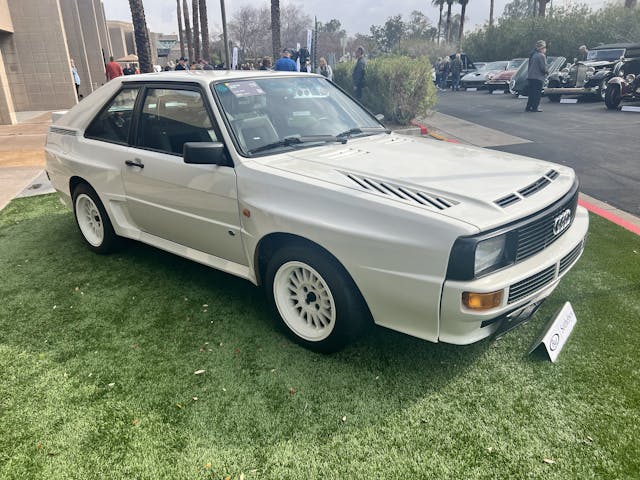
Lot 175: 1984 Audi Sport Quattro
Sold for $665,000
Chassis no. WAUZZZ85ZEA905147. Visually maintained, largely original, #2- condition
White over gray leather, black cloth
Equipment: 2133-cubic-centimeter/302-hp I-5, five-speed transmission, white wheels, Yokohama tires, Recaro seats, factory cassette player, power windows, books, and tools
Condition: Believed to be the only Sport Quattro delivered to Japan. Showing 8809 km (5474 miles). Good paint and exterior plastic with light age. Small paint scrape on the right front wheel. Light but significant wear on the driver’s seat bolsters. Not showroom fresh or anything, but a well-cared-for and seldom-driven example of Audi’s Group B homologation road car.
Bottom line: The Sport Quattro was Audi's first design to fully take advantage of regulations (or the lack thereof) in the Group B era of the World Rally Championship. Compared to the original Quattro that first introduced four-wheel drive to rallying, the Sport Quattro is more than a foot shorter, features carbon-Kevlar body panels, and has wider wheels stopped by brakes derived from the Porsche 917. It's these Sport Quattros, with flames shooting out the exhaust accompanied by chirps and whooshes of their massive turbo, that are among the most beloved Group B-era cars.
Collectors lust after both the rally cars and the easier-to-find-but-still-rare road cars built for homologation. This exact Sport Quattro has played an important part in the Group B market—at this same auction nine years ago, it was a breakout sale for Group B machinery at a $401,500 final price. Prior to that, Sport Quattros and other Group B cars were a very rare sight at auction, and none had ever sold for even half of what this car brought at Arizona in 2015. Surprisingly, it set the benchmark again at Arizona 2024, suggesting that enthusiasm for these 1980s World Rally weapons has not died down.
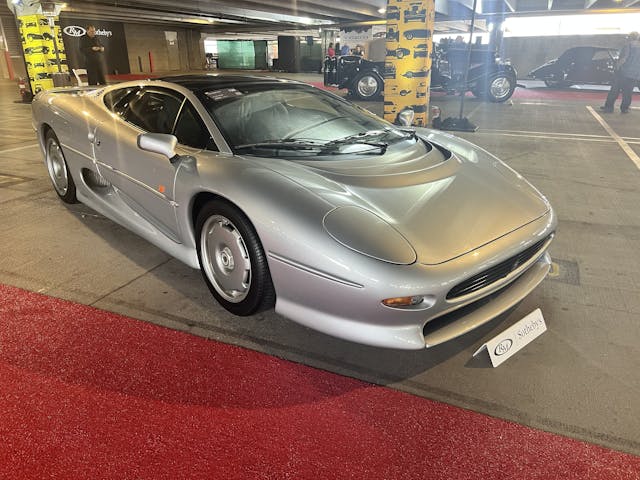
Lot 129: 1993 Jaguar XJ220
Sold for $472,500
Chassis no. SAJJEAEX8AX220686. Visually maintained, largely original, #2 condition
Spa Silver over Smoke Grey leather
Equipment: 3498-cubic-centimeter/542-hp twin turbo V-6, five-speed transmission, Pirelli tires
Condition: Major service last year. Engine rebuild, repaint, and retrimmed interior done in 2016. It's unclear why that was necessary, since the odometer shows just 6934 km (4209 miles), but the end result is a gorgeous example of Jaguar’s '90s flagship.
Bottom line: This is an XJ220 with a long auction history. It sold for $206,700 at Fall Auburn in 2003, for $154,000 at RM Phoenix in 2009, for $483,500 at RM's Elkhart Collection sale in late 2020, and for $472,500 at RM Sotheby's Monterey in 2021. It has only put another 100 km on its odometer since we saw it in 2021, and it's in the same condition. XJ220s saw a surge in value during the pandemic boom, but it wasn't as drastic as some of the more beloved '90s hypercars, and XJ220 prices have been mostly flat over the past year and a half. Identical auction results for the same car in 2021 and 2024 seem to confirm that.

Lot 159: 2020 McLaren Speedtail
Sold for $2,012,500
Chassis no. SBM23GDGXLW403069. Original, #2 condition
Liquid Blue Silver over blue and gray leather
Equipment: 4000-cubic-centimeter/1035-hp V-8 twin-turbo hybrid, dual-clutch seven-speed transmission, Pirelli P Zero tires, Liquid Blue Silver calipers, 10-spoke diamond cut wheels
Condition: One of 106 built. Like-new condition with 54 miles. Sold new in the UK at a £2.097M ($2.726M) price with a reported $452,075 in options. In the U.S. under the Show or Display exemption.
Bottom line: Billed as a sort of spiritual successor to the McLaren F1 with a similar central-seating arrangement and identical production numbers, the Speedtail has not made anywhere near the same splash as its decade-defining ancestor. In today's market for these two ultra-exclusive hypercars, an F1 can be worth 10 times as much as a Speedtail. The sample size is admittedly small, but about a dozen Speedtails have come up for auction since the model's introduction in 2020. Half of them haven't met reserve, and sale prices have ranged from the low-$2M to mid-$3M range. This one is now the cheapest (OK, least expensive) Speedtail to sell publicly, behind a $2.315M car that sold in Monterey last year.
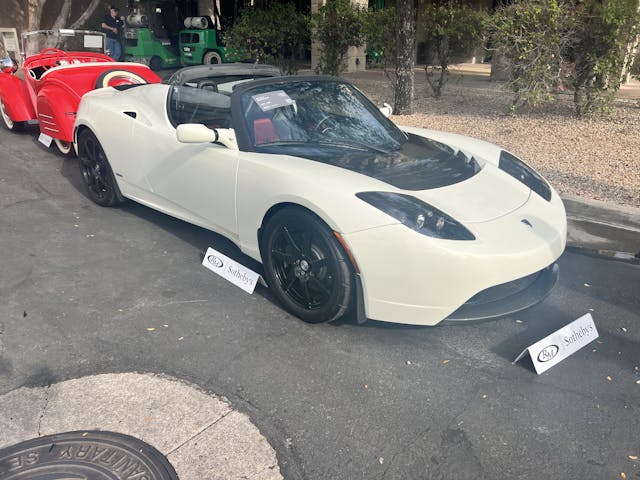
Lot 102: 2010 Tesla Roadster Sport
Sold for $49,280
Chassis no. 5YJRE1A39A1000697. Original, #4 condition
White over black and red
Evaluation: 215kW/288-hp electric drivetrain, black wheels, Yokohama tires
Condition: Represented with 3500 miles, which is reassuring. Represented with an inoperable battery that needs replacing, which isn't. Good paint and interior. Some blemishes on the wheels.
Bottom line: The first production Tesla as well as the first production EV with lithium-ion batteries, the Tesla Roadster has all the ingredients of a collector car (dynamic chassis, limited production of less than 2500 units, sexy looks). Their prices have risen to the point where they're worth comfortably more than the more conventional Elise from which they borrow their chassis. This example, though, is garage art until someone performs a five-figure battery replacement. Unlike the Toyota engine in the Elise which will last forever if maintained, EV powertrains have a shelf life. Consider this a possible glimpse into the future, then. As EVs become collectible historic vehicles, the chance of them being inoperable may be significant.
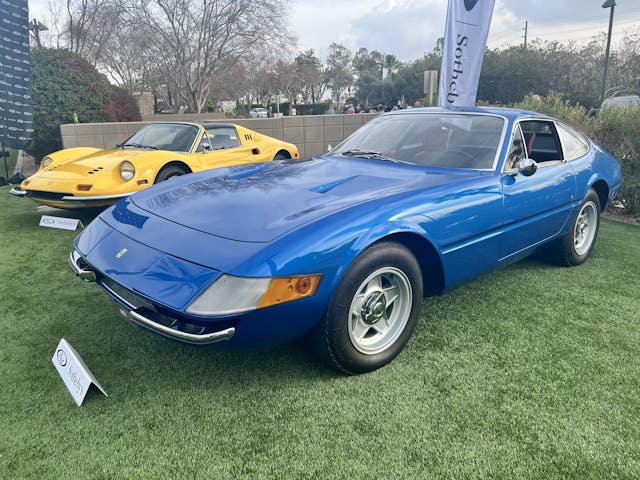
Lot 130: 1972 Ferrari 365 GTB/4 Daytona
Sold for $632,000
Chassis no. 15229. Recent restoration, #2- condition
Blu Dino over tan and black leather
Evaluation: 4390-cubic-centimeter/352-hp V-12, five-speed transmission, Ansa exhaust, Cromodora centerlock alloy wheels, leather-wrapped steering wheel, Becker Grand Prix radio, power windows, air conditioning
Condition: Restoration by GTO Engineering finished in 2019. Matching numbers. Crack below a front corner of the hood. Otherwise good paint, and this is a really sharp color on a Daytona. Light rip in the upholstery around the right rear quarter window. Lightly scratched window frames. Good, lightly worn interior.
Bottom line: This car was at Amelia Island six years ago, where it sold for $621,000. That was before its restoration, when it was painted red and in #3+ condition. Daytona prices aren't far off from where they were in 2018, so even though the restoration made a big difference in the car's appearance, it didn't, at least in the eyes of a bidding audience, make a big difference in its value.
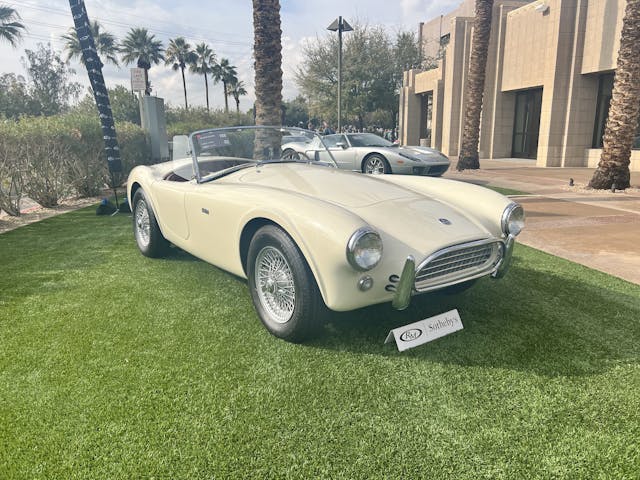
Lot 153: 1963 Shelby Cobra 289
Sold for $1,215,000
Chassis no. CSX2044. Visually maintained, largely original, #3 condition
White over red leather
Evaluation: 289-cubic-inch/271-hp V-8, four-speed, painted wire wheels, Cooper tires, wind wings, wood-rim steering wheel, Smiths gauges, heater, chromed air cleaner, aluminum rocker covers
Condition: Represented as the first 289 Cobra, and billed by RM Sotheby's as "likely the most obsessively documented Cobra on the planet." Three owners since new, and showing 27,707 supposedly actual miles. The chassis was originally slated to get the 260 engine used in the earliest Cobras, but numerous changes and delays to the original owner's order meant that he got the newer, larger 289. A California scientist, he drove the Cobra for 23,000 miles before knocking a muffler loose and stowing it away in his garage, apparently too busy working on the first Macintosh computers.
The car is now largely original other than a repaint and upgraded carburetor (the roll bar and dual mirrors it originally came with are not fitted), and all the better for it. The cockpit, though, is a bit past the point of patina and is now just tattered. The carpet is faded and worn, the door panels ripped, and the seats both ripped enough that stuffing is coming out on each side. I’d feel nervous just sitting in there.
Bottom line: While this isn't the first Cobra ever (that car sold for $13.75M in 2016), being the first 289 has to count for something, and so does originality considering how many genuine Cobras have long since been restored. The Arizona bidders placed a healthy premium on both, pushing it to a low-$1M price. Healthy, but not excessive. It's above what other early 289s in perfect condition could sell for but still within sight of them.
***
Want a better understanding of what’s driving collector car values? Sign up for the Hagerty Insider newsletter.



“This example, though, is garage art until someone performs an eight-figure battery replacement. Unlike the Toyota engine in the Elise which will last forever if maintained, EV powertrains have a shelf life. Consider this a possible glimpse into the future, then. As EVs become collectible historic vehicles, the chance of them being inoperable may be significant.”
First, a Tesla Roadster battery replacement is not an “eight-figure” job. Maybe very low five figures, which is reflected in the sales price.
Second, I don’t know of any ICE engine that “will last forever if maintained.” Internal combustion engines eventually wear out, despite our best efforts.
Third, I suspect that 30 years from now, you will have far, far greater difficulty in keeping an ICE vehicle on the road than you will an EV. Even today, I see a cottage industry of shops that covert ICE classics to electric power, but I’m not seeing any internal combustion engines being placed in worn-out EVs. I suspect it will only get easier and cheaper to refurbish an older EV. Drop-in “crate” solutions are certainly on the way.
I don’t own an EV and prefer ICE vehicles at this point in time, but I think the author’s position is either misinformed or simply ignorant of reality.
Villeneuve97: Five figures is correct. That’s on me. -Eddy